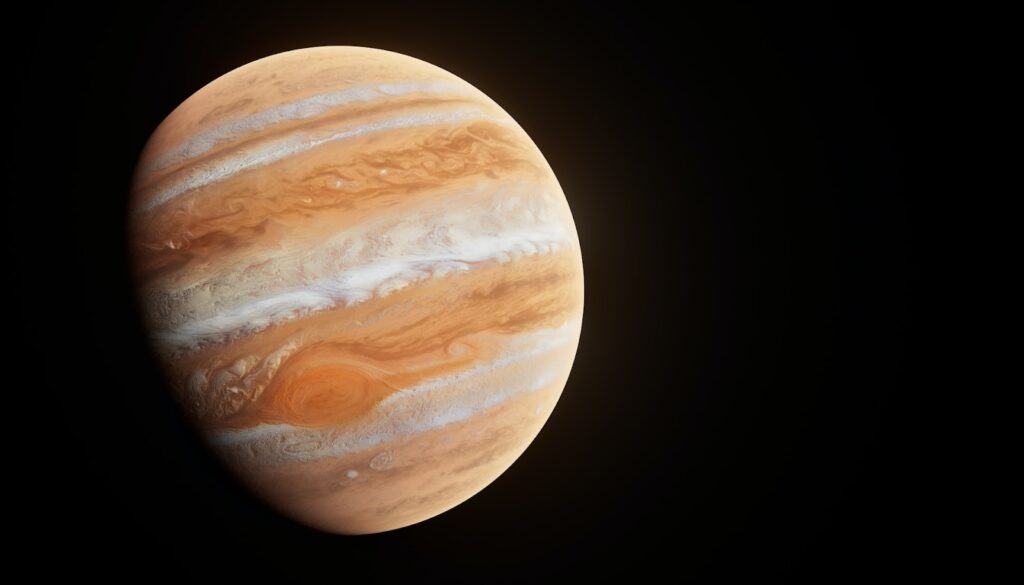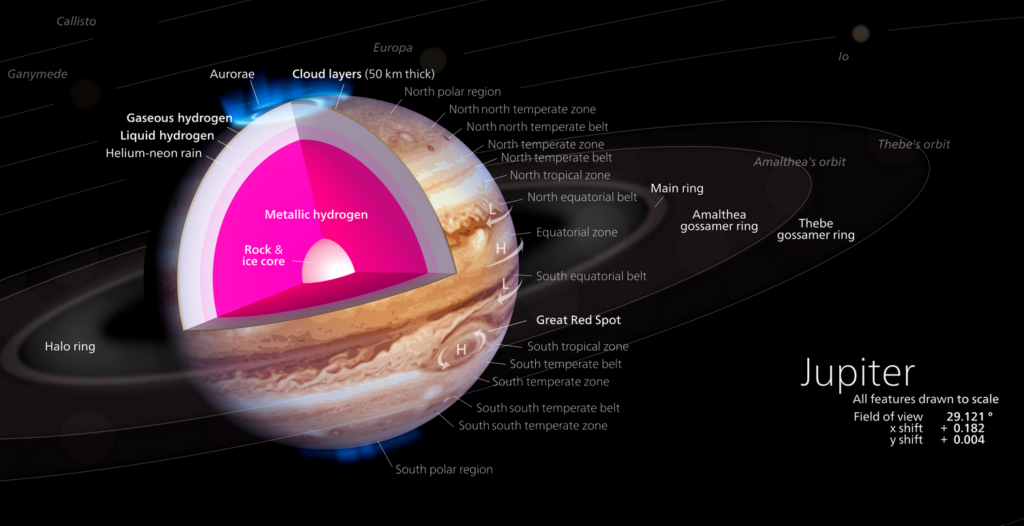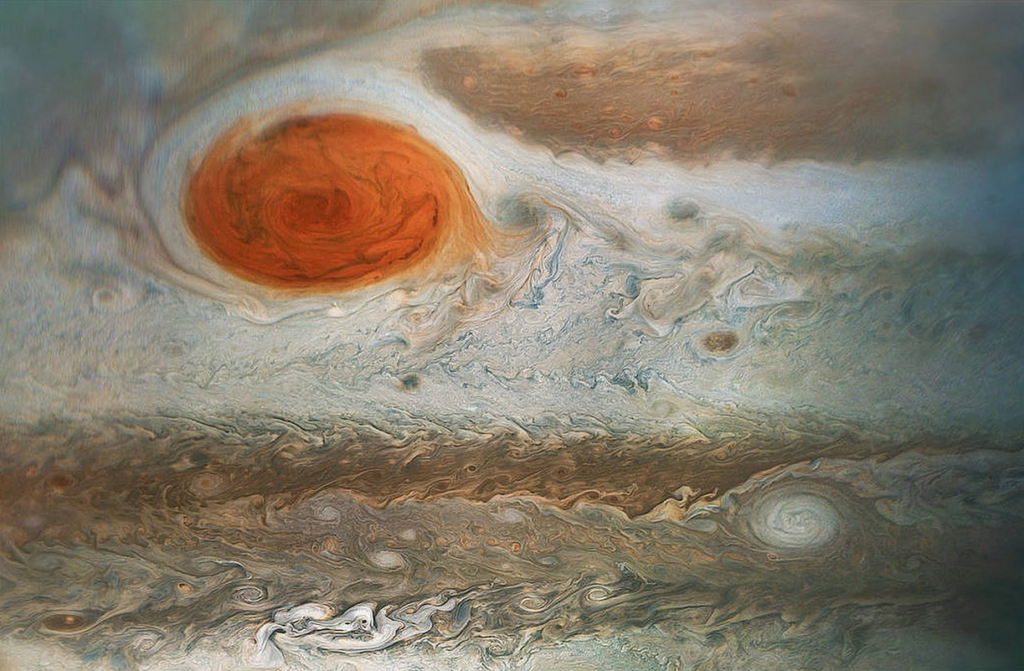You may have heard Jupiter the planet described as a failed star but what does that mean? In this article we are going to take a look at the largest planet in our solar system to find out more about it. Ultimately we will look into this rumor and try to answer the question: is Jupiter a failed star?
What Is Jupiter?
Jupiter is a vast gas giant planet in our solar system which is the fifth planet from the sun. It is also the third brightest natural object in Earth’s night sky after the Moon and Venus. When viewed you will notice stripes around Jupiter, these are cold, windy clouds of ammonia and water that are floating on an atmosphere of hydrogen and helium.

Another notable feature of Jupiter’s appearance is the so-called Great Red Spot. This is actually a storm that has been raging on Jupiter for hundreds of years which is larger than the Earth.
What Is a Gas Giant?
Earlier we mentioned the term Gas Giant while describing Jupiter but what exactly does that mean? Well essentially a gas giant is a large planet such as Jupiter and Saturn in our own solar system which is mainly composed of helium and/or hydrogen.
These planets do not have hard surfaces like our own planet, they are instead made up of swirling gases above a solid core. As such gas giants as the name suggests can be massive and often tend to be closer to their stars than other planets.
The gas giants in our own solar system are not typical of those found elsewhere in the universe. Generally speaking gas-dominated planets like Jupiter orbit extremely close to their parent stars and usually circling them in as few as 18 hours. These gas giants are often referred to as hot Jupiter’s although our own Jupiter is far from hot.
Jupiter’s Structure
Jupiter is mainly composed of hydrogen which makes up roughly 90% of its volume, this is followed by helium, which makes up about a quarter of its mass and a tenth of its volume. Most of Jupiter’s heat is created through ongoing contraction of its interior. The heat generated within Jupiter itself is more than it receives from the Sun.

Due to Jupiter’s rapid rotation rate of 1 rotation every 10 hours, the planet’s shape is best described as an oblate spheroid. On close inspection you would note a slight bulge around the equator. As mentioned stripes around Jupiter are caused by the outer atmospheres division into a series of latitudinal bands. Within these bands turbulence and storms rage along the boundaries. The Great Red Spot, is a giant storm caused by this which has been observed since at least 1831.
Another feature of Jupiter is that it is surrounded by a faint planetary ring system. It also has a powerful magnetosphere which is the second largest contiguous structure in the solar system.
Moons of Jupiter
Jupiter forms a system of 95 known moons and likely many more. These include the four large moons discovered by Galileo Galilei in 1610:
- Io
- Europa
- Ganymede
- Callisto
Ganymede is the largest of the four and is in fact even larger than the planet Mercury. Callisto is the second largest of the four while Io and Europa are similar in size to our own Moon.
Although the exact number of moons of Jupiter is not yet known, what is clear is that this huge planet has literally thousands of small objects in its orbit. Our ability to spot small moons around planets has become so good that the International Astronomical Union has decided that the smallest found can no longer be given the traditional mythological names. In order to have such a name the newly found moon must be of significant scientific interest.
History of the Observation of Jupiter
Babylonian astronomers first recorded Jupiter’s presence in the night sky around the 7th or 8th centuries BC. Of course it will have been visible for far longer than that and will have far predated the existence of humans.

The ancient Chinese astronomers referred to Jupiter as Suixing (Sui Star) which makes sense as observation from Earth with the naked eye makes it appear as if it is in fact a star and not a planet. Jupiter’s presence in fact became part of the creation of the Chinese Zodiac.
Chinese historian Xi Zezong has made the claim that Gan De, an ancient Chinese astronomer, made mention of a small star that appeared to be “in alliance” with the planet. If true this may indicate a sighting of one of Jupiter’s moons with the unaided eye which would vastly pre-date Galileo’s discovery of Jupiter’s moons by thousands of years.
Telescopic Research
It is thought that the first telescopic observation of a Moon other than our own was when in 1610 Italian polymath Galileo Galilei discovered the four largest moons of Jupiter. It is claimed that the day after this Simon Marius independently also discovered the moons but would not publish his work and findings until 1614.
Despite being first it was not Galileo’s names for the moons that would stick it was in fact Marius’ names for the four largest that are still used today.
In the 1660s Giovanni Cassini used a new more advanced telescope to see the spots and colorful bands of Jupiter in more detail. He was able to correctly observe the planet’s oblate shape and estimate its rotation period.
The famous Great Red Spot of Jupiter may have been observed as early as 1664 by Robert Hooke and then again the following year by Cassini. In truth though these claims can not be confirmed and it was the later drawings by a pharmacist named Heinrich Schwabe in 1831 that officially recorded the spot’s presence.
Since the earliest telescopes technology has greatly improved and we have been able to view Jupiter from space, do flybys with probes, set probes in orbit and drop them down into the planet itself.
What Are Stars?
If we are seeking the answer to Jupiter being a failed star we should probably learn a little about what stars are and how they form. So what exactly is a star? We see millions of stars in the night sky so to us they are likely our most familiar astronomical body.

These bright heavenly bodies represent the most fundamental building blocks of galaxies with some being billions of years old. They are huge energy producing balls of gas which through nuclear fusion also produce heavy elements such as carbon, nitrogen and oxygen.
How Are Stars Formed?
Hundreds of thousands of years after the Big Bang the gases released into our universe were not spread out evenly. Two main gases, hydrogen and helium, would clump together there into dense clouds of gas. As these clumps grew they would become denser and more compact. At the center of these dense clumps temperatures became hotter eventually leading to nuclear fusion.
The cloud collapses inward causing the material at the center to heat up. This is known as a protostar and the gradual build up of heat and pressure creates a star. Sometimes these clouds which also include dust may break into blobs creating multiple stars. This is why you may see stars grouped together in the night sky.
Is Jupiter a Failed Star?
So now we have learned more about Jupiter and of course what stars are we can better understand the answer to whether or not this planet is a failed star. It is evident that Jupiter has plenty of hydrogen and helium in its atmosphere and has a core which creates heat. Things would appear to be favorable for Jupiter being a star.
Why then is Jupiter a gas giant planet and not a star? The simple answer is that it is not nearly large enough. The presence of the hydrogen and helium gases is not enough in itself. There needs to be a great enough volume to create the needed pressure at the core of Jupiter to initiate the nuclear fusion.
Simply put Jupiter is and always has been too small to become a star. If it was larger and had more available fuel in the form of hydrogen and helium perhaps our solar system might have gotten a second star. If this had happened however things would be very different in our solar system and we may not have a planet with life on it.
Final Thoughts
Jupiter is called a failed star so much that its basic design matches that of the stars. As big as Jupiter is, it is not nearly large enough to actually become a star. The thermonuclear reactions required to ignite a star can not occur in Jupiter’s core so yes essentially it failed to become a star.
